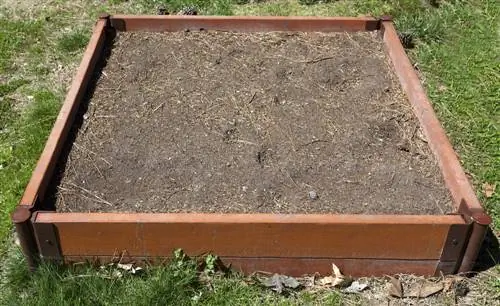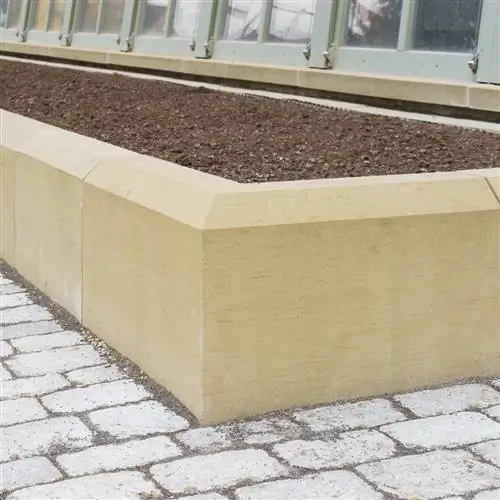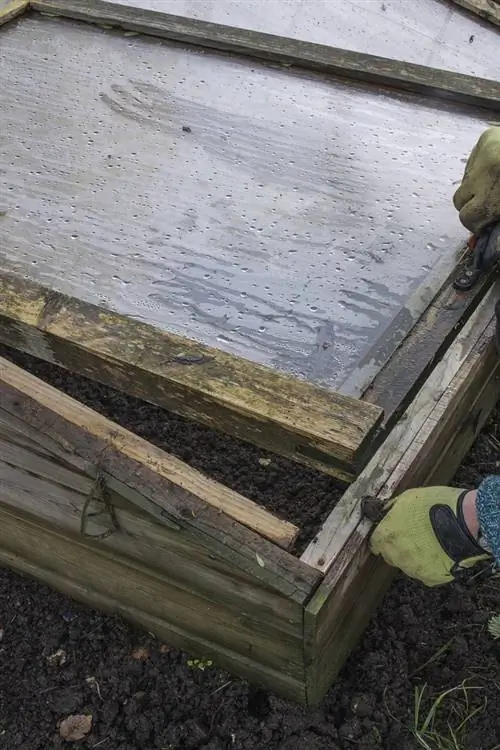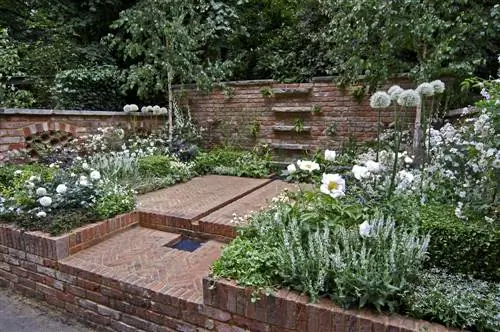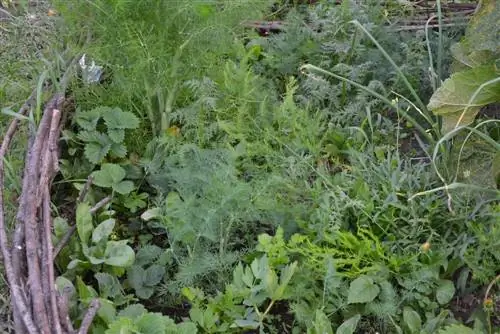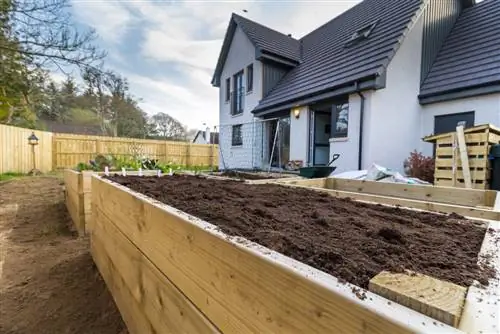- Author admin [email protected].
- Public 2023-12-16 16:46.
- Last modified 2025-06-01 06:02.
After building the raised bed made of wood, stone or other materials, the most important work now follows: filling it. The contents of the bed, carefully layered with various materials, ultimately determine how well the plants cultivated in it will thrive and how high the harvest will be. Of course, such a raised bed can also simply be filled with soil, but then as a gardener you miss out on some of the most important advantages.
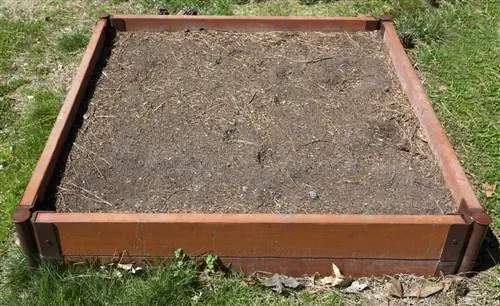
How do you fill a raised bed correctly?
You fill a raised bed by building up different layers of coarse material at the bottom (branches, twigs, stones) through plant waste and litter (leaves, grass clippings) up to the top layer of potting soil or mature compost. Thin layers of compost, horn shavings and rock dust can support nutrient formation.
When is the best time to fill the raised bed?
Raised beds can be filled in both spring and autumn, although both times have their own specific advantages and disadvantages. Beds planted in spring benefit from the heat generated by the decomposition processes, which raises the soil temperature by a few degrees - with the result that these beds can be planted two to three weeks earlier. At the same time, the problem arises, especially with beds that are only filled shortly before the gardening season, that they collapse after just a few weeks. However, if the raised bed was built in autumn, you can fill it with filling material throughout the winter: vegetable scraps from the kitchen, fallen leaves, grass clippings, shredded cuttings from trees, bedding from pet cages, hay and straw. The raised bed acts as a sort of composter that already contains the materials decomposes during the winter months.
The different layers of a raised bed
Raised beds consist of different layers, with initially coarse material being used from bottom to top, then increasingly finer material. The individual layers should never be too thick. Grass clippings, for example, are always scattered thinly and loosely into the bed so that nothing sticks together and mold cannot form as a result. Between the individual layers, repeatedly sprinkle thin layers of semi-ripe or mature compost, which inoculates the contents with microorganisms and thus promotes faster decomposition of the material. In addition, filling with fine layers of earth prevents the formation of cavities inside the bed - this can prevent the raised bed from sinking sharply.
Structure of a raised bed at a glance
When filling, make sure that the material used is not too dry. A certain level of moisture - not wetness! - already when filling would be ideal, but if necessary it can also be achieved by lightly showering freshly sprinkled layers.
The first layer
The bottom layer of the raised bed consists of coarse materials such as branches, twigs and even inorganic materials such as stones, rubble or gravel. This first layer is used for drainage and is intended to ensure that excess water can drain away quickly. If the raised bed is constructed appropriately, you can also design this layer with flat stones and larger stone slabs so that smaller animals such as lizards, slowworms or bumblebees find a home here.
The second layer
The next layer basically consists of all green waste from the kitchen and garden: vegetable scraps, leaves, grass clippings, sod and pulled weeds (but no root weeds such as groundweed, couch grass, bryony or morning glories!). If you want to use the raised bed as a cold frame in early spring, add a layer of horse manure about 40 centimeters thick to this layer. However, this must be firmly tamped down before you add further layers on top. Horse manure is important for cold frames because it generates a lot of heat.
The third layer
This is followed by several thin layers, depending on what filling material you have on hand: grass clippings, half-ripened compost, animal bedding, leaves, chopped wood, garden waste and the like. Between the individual layers there are always thin layers of mature compost as well as horn shavings and rock dust. These ensure that the filled material creates a particularly valuable and nutrient-rich soil.
The top layer
The end is always a layer of at least 15 centimeters thick of good potting soil or very ripe compost. Under no circumstances should this layer of soil be too thin, otherwise plants cultivated on the bed will not have enough space for their roots and growth will be difficult as a result. When it comes to the question of which soil should be used, the answer is actually quite simple: choose high-quality, humus-rich potting soil, which you can mix with mature compost if necessary. By the way: With bark mulch (€13.00 at Amazon) you can later mulch the plants in the raised bed and thus reduce the growth of weeds.
Fill raised bed with inorganic materials
Instead of using coarse plant material, you can also use non-rotting inorganic fillers such as stones and stone residues, gravel, grit, sand, gravel, expanded clay or granules (e.g. B. Lava). These have the advantage that the bed will no longer sink as much as a result. However, at the same time the proportion of organic green matter is reduced and thus also the proportion of newly formed soil. This means that fewer nutrients are available to the plants overall.
Tip
Do not under any circumstances compost plants in the raised bed that reproduce via their roots or tubers - mints, Jerusalem artichokes and various weeds would even reach the surface from the deeper layers and multiply diligently there. Seed weeds such as orache, on the other hand, are not a problem because the seeds and seedlings generally cannot survive the high temperatures inside.

